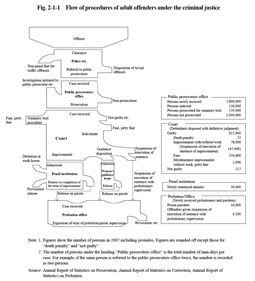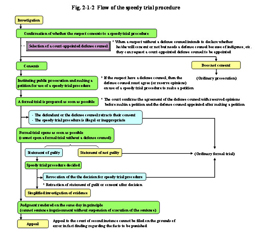| Previous Next Index Image Index Year Selection | |
|
|
Fig. 2-1-1 shows the flow of procedures regarding adult offenders under the criminal justce system of Japan. Fig. 2-1-1 Flow of procedures of adult offenders under the criminal justice All of the cases cleared by the police, etc. are referred to the public prosecutors with certain exceptions. The exceptions include those cases subject to disposition of trivial offenses (refers to cases in which judicial police officials do not have to conduct the procedure of referring minor cases predetermined by public prosecutors such as theft, fraud, and embezzlement committed by adults to public prosecutors in accordance with the proviso of the Article 246 of the Code of Criminal Procedure) and violations of the Road Traffic Act for which non-penal fines have already been paid. In 2007, 122,263 of those cleared have been disposed by police as trivial offenses (Source: National Police Agency).In addition to investigating those referred cases mentioned above, a public prosecutor may initiate by him/herself investigation on a case when he/she becomes aware of it or receives a charge or complaint. After carrying out investigation, the public prosecutor decides whether or not the case is to be prosecuted, taking into account the existence of a crime, necessity of punishment, etc. A prosecuted case can be subject to formal trial or summary trial procedure. When found guilty in a formal trial, a sentence of death penalty, imprisonment with or without work, fine, misdemeanor imprisonment without work, or petty fine can be handed down to the offender. In the case of sentences of imprisonment with or without work of three years or less, or fines of 500,000 yen or less, the execution of sentence may, in light of circumstances, be suspended for a fixed period. In such cases, probationary supervision can be put in place during the suspended period. Clear and minor cases, excluding those pertaining to offenses punishable by the death penalty, life imprisonment or imprisonment with or without work for the short term of one year or more may be brought to the speedy trial procedure. When a court renders a judgment of imprisonment with or without work in a speedy trial procedure, it shall render suspension of execution of the sentence. Fig. 2-1-2 shows a flow diagram of the speedy trial procedure. Fig. 2-1-2 Flow of the speedy trial procedure In contrast, when subject to summary trial procedure, the case results in a fine or petty fine of not more than 1,000,000 yen, after a quick and simplified examination of written documents.If a conviction without suspension of execution of sentence is made final, the sentence is executed under instruction by public prosecutors. Imprisonment with or without work and misdemeanor imprisonment without work are carried out in prisons and other penal institutions. Penal institutions make offenders work and give them rehabilitation guidance and academic education as correctional treatment, thereby aiming for prompting them to have willingness to rehabilitate themselves and fostering their ability to adapt to society. Those offenders who are unable to pay fines or petty fines are detained in workhouses attached to penal institutions. Sentenced inmates are released on completion of their term of imprisonment. However, in some cases, the Regional Parole Board may decide that an inmate can be released provisionally before the completion of the imprisonment. Inmates released on parole are placed under parole supervision during the remainder of the term of imprisonment (parole period). A woman offender sentenced to guidance disposition for Anti-Prostitution Act violation is detained in a women's guidance home. If granted parole by the Regional Parole Board, she is then placed under parole supervision for the remaining duration of the guidance disposition. Offenders placed under probation/parole supervision receive guidance, supervision and rehabilitation aid from probation officers in probation offices and volunteer probation officers. |

